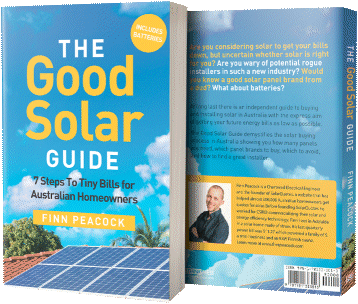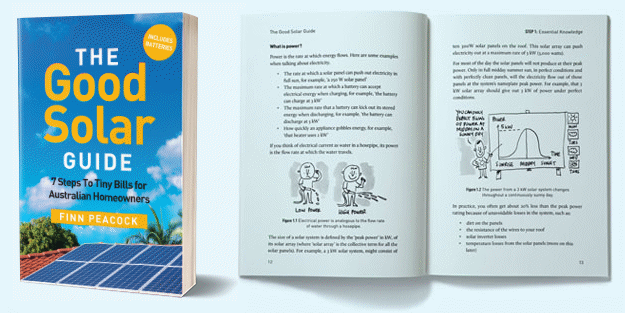Your solar power system is now installed and the installer has headed off. Discover what to check and how to ensure it keeps slashing your power bills for decades.
Post-Installation Checks
Spending 10 minutes carrying out the following checks immediately after your system is installed could save you years of headaches. If you’re impacted by any of these issues, call your installer to rectify the situation.
Inverter
Is your solar inverter exposed to full sun? A bit of morning sun isn’t a problem, but afternoon rays are an inverter (and sometimes, a warranty) killer. If it is in full sun, you need to get your installer back to stick a shade over the inverter. There are specific products such Sunny Covers and FC Inverter Covers, or a cheaper awning available from major hardware stores will do the job.
AC isolators
Your wall mounted isolators should have conduit coming in from the bottom, not the top. Water follows gravity and you don’t want rainwater getting into your electrics.
Inverter cabling
This should be neat and tidy, not hanging loose. As well as looking awful, loose cables are just waiting to be snagged on something.
Conduit on the roof
The use of exposed conduit isn’t desirable, but is sometimes needed. However, it must be UV-protected rigid conduit, not flexible, as that will degrade over time.
Solar panel alignment
Your panels should be sitting straight and level. Crooked panels usually means a rushed installation.
‘Diving board’ clamping
Panel clamps too close to the middle of the frame mean the solar panel is more likely to flex and crack.

Example of ‘diving board’ solar panel clamping
Solar panel shading
If anything such as trees, stink-pipes or satellite dishes are casting shadows on your solar panels, this is something the installer should have discussed with you pre-install and made you aware of the hit to overall performance.
Paperwork!
Make sure the installer has given you everything, including warranty documentation and user manuals.
See a full list of all the documentation you should have been provided. This is important stuff, so don’t put off chasing up the installer.
Maddening Meter Upgrades
Once your installer has confirmed everything is working as it should, they have to turn the system off. This is because your electricity meter will need upgrading or reconfiguring and this is out of the installer’s hands; much to their (and your) frustration.
“This isn’t your installer’s job,” says SolarQuotes founder Finn Peacock. “It’s up to the electricity company, or in Victoria, your network provider. And let’s just say that they don’t exactly move at light speed.”
And as for costs involved, some power companies will do what needs to be done for free; some might charge a small fee and others the full whack ($300 or more).
Maximising Your Solar Savings
It’s all about when you use your power. Every kilowatt-hour of solar electricity you use in your home is worth up to 10X more than what you get for sending it back into the grid (the feed-in tariff).
Self-consumption is the name of the game.
For example, put your power-hungry appliances on a timer and try pre-cooling or pre-heating your home during the ‘solar window’. Also switch your pool pump or electric hot water system to daytime-only.
Speaking of solar savings, remember what appears on your electricity bill is *only* for the feed-in tariff, not all the money you save by not buying power from the grid; which your electricity company can’t see. But look at your overall usage. Assuming you have pretty consistent electricity usage patterns, the number of kilowatt-hours (kWh) consumed on average noted on your bill should be lower compared to the same period in the previous year.
However, if you’re mainly using electricity at night, this might not be the case. Again, it’s a matter of time-shifting appliance use where you can. Another situation could be complacency through having solar panels installed.
If your first post-solar bill covering the full period the system has been operating worries you, call your installer. A good installer will sit down with you and explain the system’s impact on your electricity bill. If you can’t see any solar feed-in tariff credits on your bill, get onto your power company as it may be an issue at their end.
System Performance Concerns
Another issue that confuses many new solar owners is their system not (or rarely) hitting its peak *power* rating. We’ve explained this in a recent blog post on how solar systems work.
What really matters is how much *energy*1 it produces over time. A very easy way to determine if the system is performing satisfactorily is to use the SolarQuotes solar calculator and compare the figures it outputs.
“Seriously, 99% of the time, when people do this and check, their system is performing exactly as it should,” says Finn. “But if your numbers are more than 10% off what they should be and you don’t have obvious issues like shade, then yep, give your installer a ring.”
Should You Clean Solar Panels?
In most cases (unless you live somewhere particularly dusty or dirty), and assuming your solar panels are tilted more than 10 degrees, you don’t need to clean them — let the rain do the work. Even if you do clean them, you’ll probably only squeeze a couple more percent power out of the system. That’s not worth the effort or the risk of falling off your roof.
But if your panels are laid flat, you’ll need to get them cleaned around four times a year or accept a 15-20% reduced output due to dirt build-up. Again, for safety reasons, get a professional in to clean them. There are solar-focused services, and even most window-cleaners should be able to do the job.
System Inspections
Stop small problems becoming big ones. Any weakness in a system will be amplified over time through the impact of use and exposure to the elements. But even with a perfect installation, you have expensive equipment sitting out in the weather 24/7. That’s why you need to get a proper solar system inspection from an accredited installer periodically — Finn recommends every 5 years — and this is compulsory in Victoria, South Australia and the ACT.
Get your original installer to carry it out if possible as they know the system. If they are no longer around, SolarQuotes can hook you up with someone trustworthy.
Beyond Solar
Number one tip — if you really want to crush your bills, make your house less ‘leaky’. Address gaps, glazing and insulation and it will make your home comfortable year-round and reduce heating/air-conditioning use. Learn more about home thermal efficiency.
What about adding batteries?
The national government battery rebate makes it a great time to install a home battery, but there may still be a long payback period depending on your circumstances. Ask your installer to do the math, or use the SolarQuotes battery calculator.
Consider a heat pump hot water system
Heating water is usually the most energy-intensive activity for households. Finn recommends seriously considering replacing your existing system with a heat pump hot water system.
“They’re super-efficient and the cheapest way to heat your water,” he says. “The energy saved every year with a heat pump can power the typical EV.”
.. and on that note:
Electric cars
If you think you’ll get an EV in the future, check your solar system is big enough to handle charging an EV *and* running your house.
“That’s why I upgraded from 6 kilowatts of solar to 20 kilowatts,” says Finn, whose household has two electric vehicles (so far).
In addition to this article and the video above, further information and diagrams can be found in Finn’s full guide to owning solar power systems. By the way, check out everything you need to know about understanding, buying and owning solar and battery systems (and home EV charging) in Finn’s hugely popular Solar 101 guide series.
Footnotes
- Learn about the difference between power and energy – it’s important to know. ↩






 RSS - Posts
RSS - Posts



If you bought your system from Solar Run, you will find that they cease to exist once they have your money.